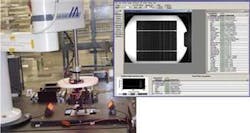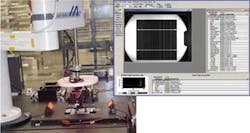Systems perspective maximizes the potential of vision
A discussion with Erik Goethert of Boston Engineering
VSD: How are you using machine vision and automated systems?
Goethert: Boston Engineering uses machine vision to improve many industrial tasks, from process monitoring and control to predictive maintenance and quality control. One area in which we see a multitude of applications for machine vision is inspection. A large percentage of the automated systems we design for our customers are built around the inspection station. Many of these are for process control and quality control inspection.
Because the inspection step is such a critical component of the entire manufacturing-automation process, the design and reliability of the vision system used must be carefully considered. Not only must the individual components of the machine-vision system-the camera, vision processor, software library, lighting, and optics-work together for the inspection process to be successful, but the inspection system must be well integrated with the rest of the manufacturing process to ensure an efficient and accurate outcome.
That’s why when designing systems for manufacturing and automation, we treat the machine-vision system as a critical piece of the bigger machine puzzle. Boston Engineering takes a systems approach, considering the entire machine design from mechanical, electrical, and software engineering to the specific machine-vision needs. As visual inspection becomes more complex, the accompanying components and electro-mechanical machine has to evolve as well.
VSD: How do you approach a new application? Do you work with OEMs or other system integrators?
Goethert: We approach machine vision from a broad systems perspective, whether for manufacturing, medical-device, or commercial products. With the increasing variety of smart sensors, components, and PC-based software available to integrate machine vision into automation and processes, it’s more important than ever to ensure all components of an automated system work optimally together. A systems approach to engineering will help ensure the success of a machine-vision project, even if the rest of the system has already been designed or if machine vision is being added to a pre-existing system.
For each application we use a standard, proven methodology. We start by creating a detailed specification that addresses all possible steps, deliverables, and responsibilities, and ensure that it is approved by our team as well as the client’s team. After a concept has been selected, the detailed design begins. We use a phased-gate approach-based on our Total System Responsibility philosophy-that includes thorough documentation to ensure the project is correct the first time.
In phase one, we determine the system specification and define goals based on measurement, control, or outcome. Phase two is a concept matrix for brainstorming and modeling to help us select the optimal solution. We may image a sample of the parts in our lab to determine correct lensing and lighting. Once the optimal solution is selected, we design all aspects of the machine-electrical, mechanical, and software-before we build. We ensure quality of the system through many design reviews internally and with the customer. Production documentation is the final part of any system design we do.
VSD: What technologies and components do you use in these applications?
Goethert: We are vendor-independent and strive to match the most cost-effective, proven quality with innovative technologies to provide our clients with a solution that will best meet their needs-from a time, cost, quality, and budget perspective.
One type of component we find useful for applications that don’t require extremely high speed or computationally intensive algorithms is the so-called smart camera. With their on-board processors, these cameras offer internal functionality that reduces the number of analysis steps needed later. For other applications, we typically use an area- or linescan frame grabber coupled with a high-end CCD camera, depending on the type of image and analysis needed. We have used standard cameras, as well as infrared cameras from FLIR Systems (Billerica, MA, USA; www.flirthermography.com). On the software side, we have used Dalsa Coreco (St.-Laurent, QC, Canada; www.coreco.com) Sapera tools for C/C++, MVTec Software (Munich, Germany; www.mvtec.com) Halcon MVTools for C/C++, and National Instruments (Austin, TX, USA; www.ni.com) Vision Tools for LabVIEW. The decision about software selection depends on many issues, including whether real-time processing is needed for a closed-loop process control, whether multiple camera inputs are needed, or whether the camera-such as many of the FLIR models-offers embedded processing.
Many times we can use complementary technology such as mirrors or staging to simplify the system. In one example, we reduced the number of vision systems needed by using a rotating axis, thereby reducing the cost. Understanding the overall system needs, rather than just designing toward machine vision, helped us achieve this solution.
VSD: In which areas do you see the most growth? What are users demanding from you in the design of new systems?
Goethert: We are seeing the most growth in the use of IR cameras for process control and part inspection. The cameras have come down in price enough for these systems to be cost-effective. The infrared spectrum has opened many process-control and part-inspection opportunities. For example, one of the failures in a ceramic heating element is a crack that is not detectable by the human eye. However, if the part is excited with a current and heating occurs, the crack is readily visible in the IR spectrum. By implementing a test that compares the temperatures of the two legs of the element by measuring the height of two peaks in the FOV of the image, we can determine which parts are failing.
For many of the long-term “staring” applications where the customer is measuring the temperature of a surface, we are seeing an increase in wireless networked cameras for this remote monitoring. Instead of using thermocouples or other temperature measurement sensors on these surfaces, the IR cameras are the perfect solution. This is especially true when absolute temperatures are not as important as relative temperatures.
Regardless of the type or complexity of the system, all of our customers are demanding reliability--zero down time. The more we simplify the system, the more reliable the system becomes Reviewing the entire system, not just the machine vision, helps us find ways to simplify automation while improving reliability.
VSD: How is each OEM component more or less important for the applications that you serve?
Goethert: The vision system is only as good as its weakest component. If a component isn’t important we try to find a way to eliminate it to reduce complexity and cost, and increase reliability. This level of “end goal” thinking is part of our overall systems approach to engineering. We’re not just designing vision systems, but striving to improve the reliability and overall cost-effectiveness of the entire system.
Within the vision system, the camera itself and the lighting are critical. We think of lighting as the “signal conditioning” for visual inspection. If the features of interest do not have enough contrast because of poor lighting, the software analysis will not be reliable. It’s a matter of “garbage in, garbage out,” as the saying goes. For inspection applications, reliability is critical so we can’t afford for any of the data to be less than perfect.
We stay updated on the latest technology and do careful review and testing before determining which components to select. We’re not married to any one vendor, so we can select the components that best meet the end goal, or fit within the client’s existing architecture.
VSD: What could vision-equipment manufacturers do to make your implementation jobs easier?
Goethert: In many cases the software interface could be cleaner. There are hardware standards in the industry, and most of the high-end systems provide software libraries and can be programmed in a high-level language. If this software were standardized, implementation would be expedited.
VSD: What kinds of new applications do you expect to emerge?
Goethert: We see a natural growth in the number of vision systems deployed in manufacturing as plants become more and more automated. We see growth in laboratory settings, as well. But the demands on these vision systems are moving toward increasing precision-the ability to detect minute details. With the advancements in IR technology and the corresponding drop in price, we see IR imaging as a growth market. With IR, many details that are not possible in the visible spectrum become available. IR is the next frontier of imaging technology to benefit almost all industries.
In general, the utilization of machine vision is becoming pervasive in all industries that need to augment or improve on the reliability of human vision. With emerging technologies in wireless communications, vision solutions can be used to gather information from many locations, including remote areas. Small, fast, cost-effective vision sensors can accurately capture quality data where having many people or expensive sensors might have been needed in the past. This not only makes machine vision more useful, but leads to an increasing demand for it as more companies expect technology to lead to increased performance and reduced costs.
VSD: How will OEM components have to change to meet these future needs?
Goethert: As with other technologies, there is a continuous need for faster image processing. The trend of adding more computational horsepower at the camera will help simplify vision systems that require this speed. The software will need to keep up.
OEM components need to be developed within the guidelines of widely adopted standards in order to be as plug-and-play as possible. Each customer solution has unique aspects, but if components can easily communicate to and work with each other, then we should see increases in utilization. In addition, all components will need to keep pace with the increased speed, lower cost, and improved quality demands of the many evolving industries, particularly electronics, medical, manufacturing, and defense/homeland security.
ERIK GOETHERT is a program manager at Boston Engineering (Waltham, MA, USA; www.boston-engineering.com). He manages the test-and-measurement area of the company and is active in all software and control engineering efforts. Goethert has a bachelor’s degree in agricultural engineering from Cornell University and has worked for several engineering companies and the US Environmental Protection Agency. Editor in chief Conard Holton spoke with him about total system design.


